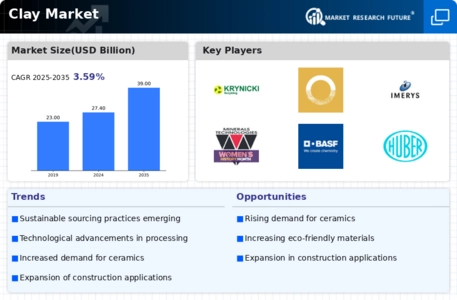Cultural and Artistic Revival
The resurgence of interest in traditional crafts and artisanal products is influencing the Clay Market. As consumers seek unique and handcrafted items, the demand for artisanal clay products is on the rise. This trend is particularly evident in the pottery and ceramics sectors, where local artisans are gaining recognition for their skills. Market analysis indicates that the artisanal segment is expected to grow by 10% annually, driven by consumer preferences for authenticity and craftsmanship. This cultural revival not only supports local economies but also encourages innovation within the Clay Market, as artisans experiment with new designs and techniques to attract a broader audience.
Expansion of Construction Activities
The ongoing expansion of construction activities across various sectors is significantly impacting the Clay Market. With urbanization and infrastructure development on the rise, the demand for clay-based materials, such as bricks and tiles, is expected to increase. Recent statistics indicate that the construction sector is anticipated to grow by 5% annually, which directly correlates with the rising need for clay products. This growth is further fueled by government initiatives aimed at improving housing and infrastructure, thereby creating a robust market for clay materials. Consequently, companies in the Clay Market are likely to benefit from this upward trend, as they align their production capabilities to meet the escalating demand.
Rising Demand for Eco-Friendly Products
The increasing consumer preference for sustainable and eco-friendly products is driving the Clay Market. As environmental awareness grows, manufacturers are adapting their offerings to meet this demand. This shift is evident in the rise of natural clay products, which are perceived as safer and more environmentally friendly compared to synthetic alternatives. According to recent data, the market for eco-friendly materials is projected to grow at a compound annual growth rate of approximately 8% over the next five years. This trend not only influences product development but also encourages companies within the Clay Market to adopt sustainable practices in their production processes, thereby enhancing their market appeal.
Innovations in Clay Processing Techniques
Innovations in processing techniques are transforming the Clay Market, enabling manufacturers to enhance product quality and efficiency. Advanced technologies, such as 3D printing and automated molding, are being integrated into production processes, allowing for greater precision and reduced waste. This technological evolution not only improves the aesthetic appeal of clay products but also increases their functional properties, making them more competitive in the market. Data suggests that the adoption of these innovations could lead to a 15% reduction in production costs, thereby benefiting both manufacturers and consumers. As these advancements continue to evolve, they are likely to redefine the standards within the Clay Market.
Increased Applications in the Healthcare Sector
The expanding applications of clay in the healthcare sector are emerging as a notable driver for the Clay Market. Clay Market minerals, such as kaolin and bentonite, are increasingly utilized in various medical applications, including drug delivery systems and wound healing products. Recent studies highlight the potential of clay-based materials to enhance therapeutic efficacy and patient outcomes. The healthcare market for clay products is projected to grow at a rate of 6% per year, reflecting the rising interest in natural and biocompatible materials. This trend not only diversifies the applications of clay but also positions the Clay Market as a key player in the healthcare landscape.

















